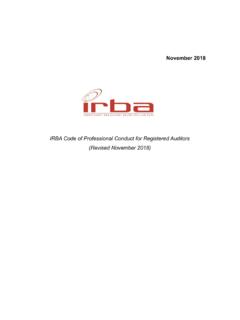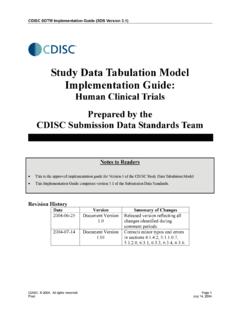Transcription of SEXUAL VIOLENCE SURVEILLANCE
1 SEXUAL VIOLENCE SURVEILLANCEUNIFORM DEFINITIONS AND RECOMMENDED DATA ELEMENTSN ational Center for Injury Prevention and Control Division of VIOLENCE PreventionSEXUAL VIOLENCE SURVEILLANCE : UNIFORM DEFINITIONS AND RECOMMENDED DATA ELEMENTSVERSION C. Basile, PhDSharon G. Smith, PhDMatthew J. Breiding, PhDMichele C. Black, PhD, MPHR eshma Mahendra, MPH2014 Centers for Disease Control and Prevention National Center for Injury Prevention and Control Atlanta, GeorgiaSexual VIOLENCE SURVEILLANCE : Uniform Definitions and Recommended Data elements , Version is a set of recommendations designed to promote consistency in the use of terminology and data collection related to SEXUAL VIOLENCE . This document was developed through an extensive consultation process. It is published by the National Center for Injury Prevention and Control of the Centers for Disease Control and for Disease Control and PreventionThomas R.
2 Frieden, MD, MPH, DirectorNational Center for Injury Prevention and ControlDebra Houry, MD, MPH, DirectorDivision of VIOLENCE PreventionJames A. Mercy, PhD, Acting DirectorSuggested Citation: Basile KC, Smith SG, Breiding MJ, Black MC, Mahendra RR. SEXUAL VIOLENCE SURVEILLANCE : Uniform Definitions and Recommended Data elements , Version Atlanta (GA): National Center for Injury Prevention and Control, Centers for Disease Control and Prevention; OF CONTENTSP anel Members ..ivExternal Reviewers ..vAcknowledgements ..viIntroduction ..1 Uniform Definitions ..9 SEXUAL VIOLENCE and Associated Terms ..11 Involved Parties ..13 Terms Associated with Circumstances and Consequences of VIOLENCE ..15 Recommended Data elements for Record-based and Survey SURVEILLANCE of SEXUAL VIOLENCE ..19 Record-based SURVEILLANCE ..21 Survey SURVEILLANCE ..23 Recommended Data elements for SEXUAL VIOLENCE ..27 Section 1.
3 Identifying Information ..29 Section 2. Victim Demographics ..35 Section 3. Victim s First Known Incident of SEXUAL VIOLENCE ..51 Section 4. Victim s Most Recent Incident of SEXUAL VIOLENCE ..65 Technical Notes ..103 References ..111 Appendices ..117 Appendix A: Panel Members and External Reviewers for 2002 Publication ..119 Appendix B: Summary of Recommended Data elements ..123ivPANEL MEMBERSE tiony Aldarondo, PhD Associate Dean for Research Director, Dunspaugh-Dalton Community and Educational Well-Being Research Center School of Education University of Miami 5202 University Drive Coral Gables, FL 33146 Sarah Cook, PhD Professor of Psychology Associate Dean of the Honors College Georgia State University Box 5010 Atlanta, GA 30302 Christine Gidycz, PhD Professor of Psychology Department of Psychology Ohio University Athens, OH 45701 Sherry Hamby, PhD Research Professor and Director, Life Paths Research Program Sewanee: The University of the South 735 University Avenue Sewanee, Tennessee 37383 Dean G.
4 Kilpatrick, PhD Distinguished University Professor of Clinical Psychology Director, National Crime Victims Research & Treatment Center Vice-Chair for Research & Research Administration Co-Director, Charleston Consortium Clinical Psychology Internship Program Department of Psychiatry & Behavioral Sciences Medical University of South Carolina 67 President Street Ste BA207, 2nd Floor IOP South Charleston, South Carolina 29425 David S. Lee, MPH Director of Prevention Services California Coalition Against SEXUAL Assault (CALCASA) 1215 K Street, Suite 1850 Esquire Plaza Sacramento, CA 95814TK Logan, PhD Professor Department of Behavioral Sciences College of Medicine and the Center of Drug Alcohol Research University of Kentucky 333 Waller Avenue, Suite 480 Lexington, KY 40504-2915 Anne Menard, CEO Director National Resource Center on Domestic VIOLENCE 3605 Vartan Way, Suite 101 Harrisburg, PA 17110 Angela Moore, PhD Director Justice Systems Research Division Office of Research and Evaluation National Institute of Justice Department of Justice Washington, Parks, PhD Senior Research Scientist State University of New York at Buffalo Research Institute on Addictions 1021 Main Street Buffalo, NY 14203 Jay G.
5 Silverman, PhD Professor of Medicine and Global Public Health Director of Research, Center on Gender Equity and Health University of California, San Diego 10111 N. Torrey Pines Rd., MC0507; Institute of the Americas La Jolla, California 92093-0507vEXTERNAL REVIEWERS*Nancy L. Bagnato, MPH Coordinator VIOLENCE Prevention Unit Safe and Active Communities Branch California Department of Public Health 1616 Capital Avenue Sacramento, CA 95899 Karen Baker, LMSW Director National SEXUAL VIOLENCE Resource Center 123 North Enola Drive Enola, PA 17025 Connie Burk Executive Director The NW Network of Bisexual, Trans, Lesbian & Gay Survivors of Abuse Box 18436 Seattle, WA 98118 Donna Greco, MSW Training and Technical Assistance Director National SEXUAL VIOLENCE Resource Center 123 North Enola Drive Enola, PA 17025 Binnie LeHew, MSW Executive Officer Office of Disability, Injury & VIOLENCE Prevention Iowa Department of Health 321 E.
6 12th Street Des Moines, Iowa 50319 Sally J. Laskey, MA Director of Special Projects National SEXUAL VIOLENCE Resource Center 123 North Enola Drive Enola, PA 17025 Diane Moyer, Esq. Legal Director Pennsylvania Coalition Against Rape 125 North Enola Drive Enola, PA 17025*CDC invited a large number of external reviewers representing a wide range of stakeholders. The expert reviewers listed above provided comments by the time they were due and the document was authors would like to acknowledge the work of Kathleen C. Basile and Linda E. Saltzman who authored the first version of SEXUAL VIOLENCE SURVEILLANCE : Uniform Definitions and Recommended Data elements . Their authorship provided the foundation from which we worked. Much of their work is retained in this addition to the panel members and external reviewers who helped to create and provide comments on this and earlier drafts, we would like to thank the following people for their contributions to the panel meeting and document revision process: Kathleen Rutherford, for helping to plan and facilitate the expert panel meeting; Merle Hamburger, Melanie LaGarde, and Mikel Walters for their helpful assistance in planning the expert panel meeting; Julie Gazmararian, Melissa Merrick, and Mikel Walters for their help with summarizing the notes from the meeting; Betsy Lescosky for developing the layout; and Alida Knuth for coordinating graphic design and printing Problem of SEXUAL ViolenceSexual VIOLENCE (SV) is a profound social and public health problem in the United States.
7 The range of experiences that pertain to SV is broad and affects females and males across the lifespan. As will be covered in more detail to follow, SV includes both penetrative and non-penetrative acts as well as non-contact forms. SEXUAL VIOLENCE occurs when a perpetrator commits SEXUAL acts without a victim s consent, or when a victim is unable to consent ( , due to age, illness) or refuse ( , due to physical VIOLENCE or threats). According to the National Intimate Partner and SEXUAL VIOLENCE Survey (NISVS):1 1 in 5 women and nearly 1 in 59 men have experienced an attempted or completed rape in their lifetime, defined as penetrating a victim by use of force or through alcohol/drug facilitation; Approximately 1 in 15 men ( ) reported that they were made to penetrate someone else during their lifetime; An estimated of women and of men reported SEXUAL coercion in their lifetime ( , unwanted SEXUAL penetration after being pressured in a nonphysical way); More than one-quarter of women ( ) and approximately 1 in 9 men ( ) have experienced some form of unwanted SEXUAL contact in their lifetime.
8 And Nearly one-third of women ( ) and nearly 1 in 8 men ( ) experienced some type of non-contact unwanted SEXUAL experience in their efforts to reduce the barriers to reporting these sensitive issues (for example, the behaviorally-specific questions, health context, and graduated informed consent used in NISVS), there remains a likelihood of underreporting due to the sensitive nature of SV. Therefore, many researchers and practitioners in this field believe that existing national statistics underestimate the number of victims of as SV is not limited to physically forced penetration, its perpetrators are not limited to strangers. Indeed, perpetrators of SV are more likely to be someone known to the SEXUAL VIOLENCE is a problem embedded in our society and includes unwanted acts perpetrated by persons very well known ( , family members, intimate partners, and friends), generally known ( , acquaintances), not known well or just known by sight ( , someone in your neighborhood, person just met) and unknown to the victim ( , strangers).
9 The overarching term SEXUAL VIOLENCE is used here to represent many behaviors that may otherwise fall under the rubrics of SEXUAL abuse, SEXUAL assault, and any other SEXUAL violations. In some fields, other umbrella terms are used to describe SEXUAL violations, such as the term SEXUAL harassment, which is used in studies of the workplace and the school Although many who work in the field of SV use the word survivor to describe the person on whom the SV is inflicted, the word victim is used in this document in an effort to be consistent with agencies from which most of record-based SURVEILLANCE information is gathered. For the purposes of survey SURVEILLANCE , the word survivor may be substituted for victim, as long as survivor is defined in the same way victim is defined in this VIOLENCE SURVEILLANCE :UNIFORM DEFINITIONS AND RECOMMENDED DATA ELEMENTSH istory of CDC Activities Related to the Development of Uniform Definitions and Recommended Data ElementsThe VIOLENCE Against Women Act in the 1994 Crime Bill established the Rape Prevention and Education (RPE) Program at CDC.
10 The program was administered through the Preventive Health and Health Services Block Grant handled by the National Center for Chronic Disease Prevention and Health Promotion (Chronic Disease Center). In 2001, the administration of the program moved to CDC s National Center for Injury Prevention and Control (Injury Center). The RPE program is the only national program devoted to SV prevention. The Injury Center provides SV prevention funding, training, and technical assistance to state health departments. These departments partner with and provide funding to state SEXUAL assault coalitions and over 700 local SEXUAL assault prevention the initiation of the RPE Program, CDC and the Department of Health and Human Services convened meetings with researchers, victim advocates, prevention educators and other federal leaders to discuss issues about SV definitions, lack of adequate data, prevention programs, services and support for SV survivors, evaluation of existing systems and programs, and communication between the state coalitions* and state health department staff.

















